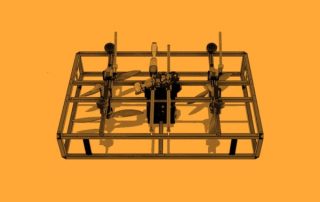Ultrasonic Thickness Measurement (UTM)
Understanding UT Technology
Ultrasonic Thickness Measurement (UTM) is a non-destructive testing (NDT) technique used to determine the thickness of materials, typically metals, by measuring the time it takes for ultrasonic waves to travel through the material and reflect back from the opposite side.
In recent years, there has been growing interest in integrating Ultrasonic Thickness Measurement with drones to perform inspections of large and complex structures, such as bridges, pipelines, storage tanks, and industrial facilities. By equipping drones with ultrasonic sensors and positioning systems, inspectors can remotely assess the thickness of materials without the need for manual measurements or scaffolding, significantly reducing inspection time and costs while improving safety.
Applications across industries
Infrastructure Inspection
Drones equipped with UTM sensors can assess the thickness of bridges, tunnels, dams, and other infrastructure assets, helping to identify potential structural issues before they escalate.
Pipeline Monitoring
In the oil and gas industry, drones can be used to inspect pipelines for corrosion, erosion, or other defects, ensuring the integrity and safety of the transportation network.
Storage Tank Inspection
Drones can perform UTM inspections of storage tanks, silos, and vessels in industrial facilities, detecting corrosion or leakage that may compromise their structural integrity.
Ship Hull Inspection
Drones equipped with UTM sensors can assess the thickness of ship hulls, propellers, and other marine structures, identifying areas in need of maintenance or repair.
Building Inspection
In the construction industry, drones can be used to inspect building facades, roofs, and other structures for signs of degradation or damage, ensuring compliance with safety regulations.
Advantages and Limitations
Benefits
1. Accurate Measurements: Ultrasonic Thickness Measurement provides highly accurate thickness readings, allowing inspectors to identify thinning or corrosion in materials with precision.
2. Efficiency: Using drones for UTM inspections enables rapid assessment of large areas or structures, minimizing downtime and disruption to operations.
3. Cost-effectiveness: Drone-based UTM inspections require fewer personnel and resources compared to traditional methods, resulting in cost savings for asset owners and operators.
4. Safety: Inspecting structures with drones eliminates the need for workers to access hazardous or hard-to-reach areas, reducing the risk of accidents or injuries.
5. Data Visualization: UTM data collected by drones can be visualized and analyzed in real-time using advanced software tools, allowing inspectors to make informed decisions quickly and accurately.
Challenges
1. Surface Condition and Material Properties: UTM measurements can be affected by surface conditions such as roughness, corrosion, or coatings, which can interfere with the transmission and reception of ultrasonic waves. Additionally, the accuracy of UTM readings may vary depending on the material properties of the test specimen, including density, porosity, and acoustic impedance.
2. Coupling Medium: Achieving proper coupling between the ultrasonic transducer and the test surface is critical for accurate thickness measurements. Variations in the coupling medium (e.g., air, water, gel) can introduce measurement errors, particularly in applications where access to the test surface is limited or the surface is uneven.
3. Geometry and Curvature: UTM measurements may be challenging in situations where the test specimen has complex geometry or curvature. Ultrasonic waves may refract or reflect differently depending on the angle of incidence, leading to inaccuracies in thickness readings, especially near edges, corners, or curved surfaces.
Ultrasonic Thickness Measurement, when integrated with drones, offers a valuable solution for non-destructive testing and inspection of structural components across various industries. Its accuracy, efficiency, cost-effectiveness, and safety benefits make it an indispensable tool for assessing the integrity of critical infrastructure and ensuring compliance with regulatory standards.
Certifications
- TerraUT drone operator certification (Level 2)
- Safety equipment




